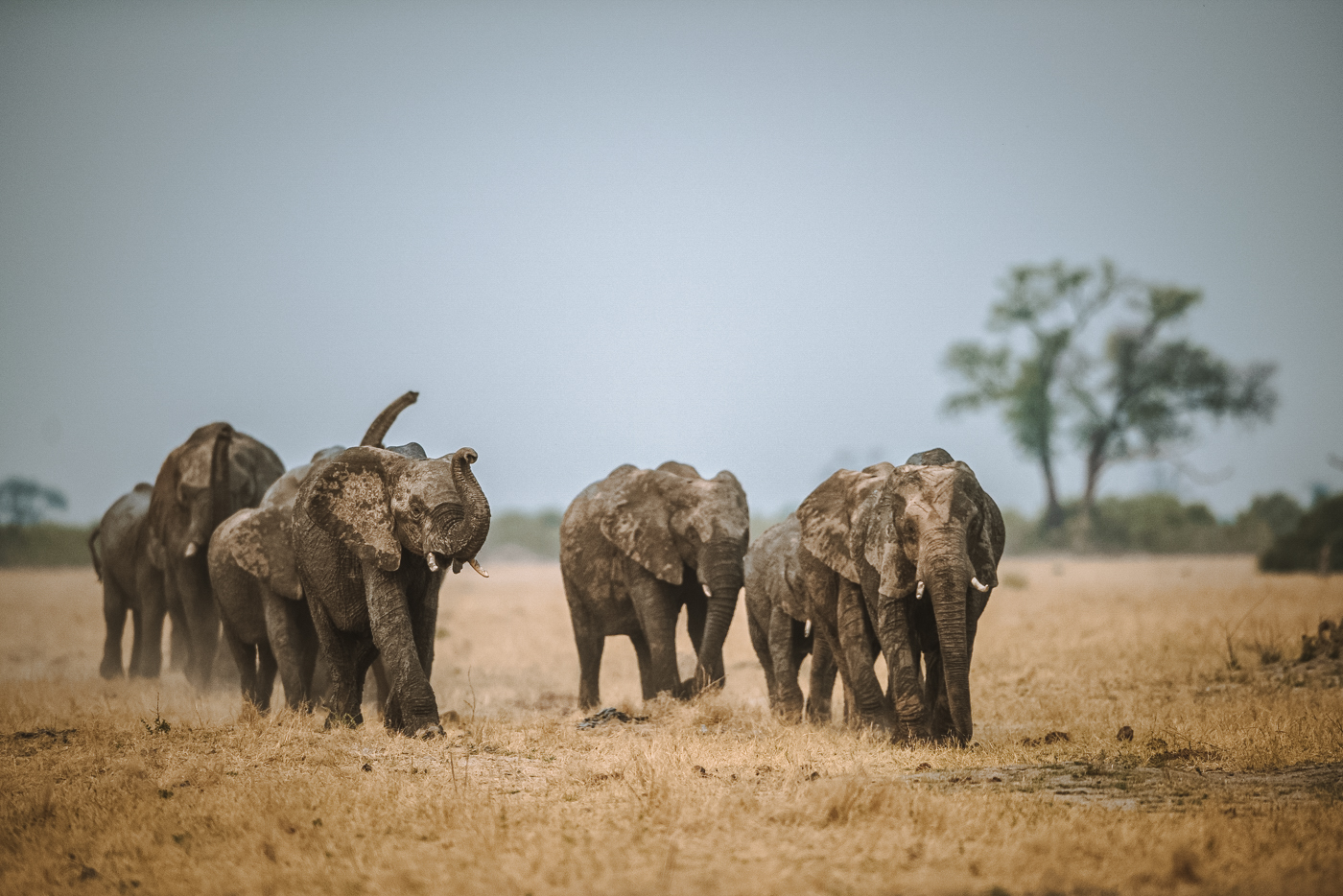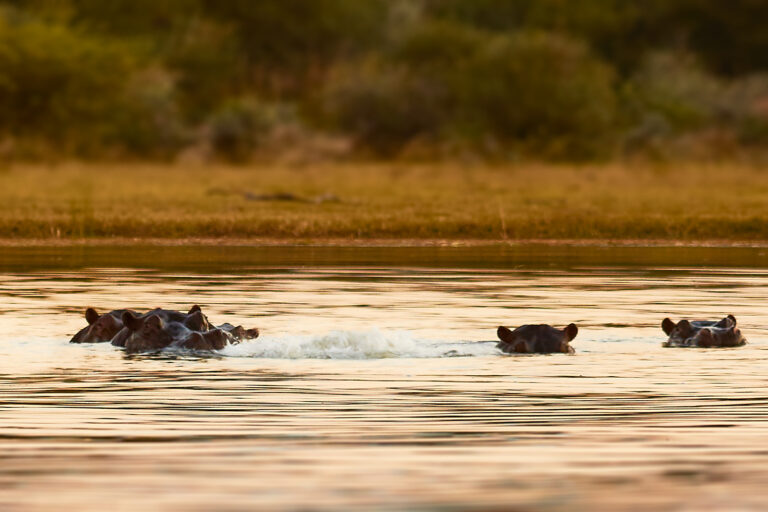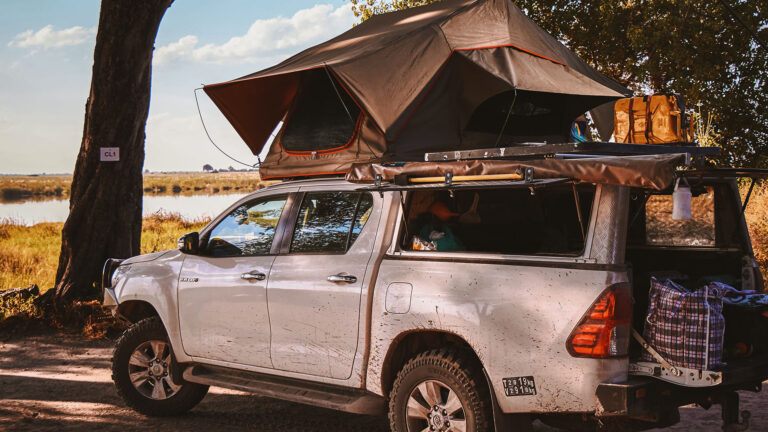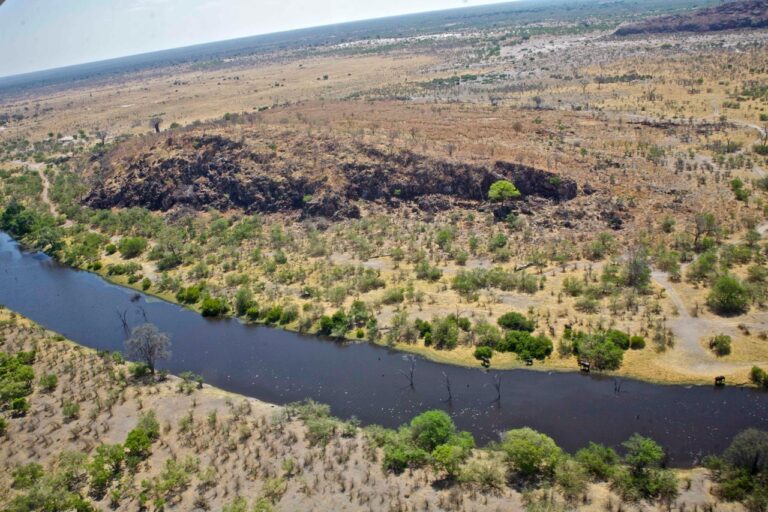Chobe National Park is a must-visit for any safari enthusiast. Known for its massive elephant population and rich biodiversity, it offers unparalleled wildlife viewing opportunities. Chobe National Park is home to around 150,000 Elephants but mainly in the winter months.
In this article, we’ll explore why Chobe should be on your safari itinerary, highlight its main areas, the best times to visit, and how to get there, ensuring you have all the information you need for an unforgettable experience.
Highlights
- Chobe National Park is famous for its large elephant population and diverse wildlife, including lions, hippos, and over 450 bird species, making it a top safari destination.
- The park features distinct regions, like the Chobe Riverfront and Savuti Marsh, each offering unique experiences and opportunities for wildlife viewing.
- Visiting during the dry season (May to early November) maximizes wildlife sightings, especially near water sources, while various safari options and accommodation cater to all preferences.
Why Chobe National Park Should Be on Your Safari List

Chobe National Park, often referred to as the “elephant capital of the world,” is home to one of the largest concentrations of elephants on the planet.
Imagine witnessing herds of these majestic creatures bathing in the Chobe River, their silhouettes framed by stunning sunsets – a sight that’s bound to leave you in awe.
But elephants are just the beginning. The park is also a sanctuary for:
- lions
- wild dogs
- hippos
- crocodiles
- an incredible diversity of over 450 bird species.
Covering approximately 11,000 square kilometers, Chobe offers a variety of landscapes, from lush floodplains and dense woodlands to expansive savannahs.
Each region within the park, such as the Savuti, Linyanti, and the Chobe Riverfront, presents unique habitats that support a wide range of wildlife. This diversity makes Chobe a paradise for wildlife photography, especially at waterholes where animals frequently gather.
The combination of abundant wildlife and breathtaking scenery creates an unmatched safari experience.
Whether you’re exploring the park’s ecosystems or capturing the perfect shot of a lion on the prowl, Chobe’s pristine wilderness offers an adventure that’s as exhilarating as it is memorable.
Exploring the Main Areas of Chobe National Park
Chobe National Park is a mosaic of distinct regions, each offering its own unique experiences. The park is divided into four primary areas:
- Ngwenzumba Pans
- Linyanti
- Savuti
- Chobe Riverfront
These regions feature a mix of wetlands, savannahs, floodplains, and woodlands, supporting a variety of wildlife and ecosystems.
Exploring these diverse areas allows visitors to experience the park from multiple perspectives, whether it’s the predator-rich Savuti Marsh, the pristine beauty of the Linyanti Marshes, or the lush Chobe Riverfront.
Each area is a haven for wildlife enthusiasts and photographers alike, offering unparalleled opportunities to witness Africa’s iconic wildlife in their natural habitats.
Chobe Riverfront
The Chobe Riverfront is a vibrant hub of activity, renowned for its lush floodplains and dense forests.
As the dry season sets in, the Chobe River becomes a vital watering spot, attracting large groups of animals, including massive herds of elephants and buffalo. It’s a spectacle of nature that draws wildlife enthusiasts from around the globe.
Birdwatchers will find the Chobe Riverfront particularly rewarding, with species like the African fish eagle and the endangered African skimmer making regular appearances. For a more adventurous experience, consider a canoeing trip on the Chobe River.
Guided by experts, these trips offer close encounters with wildlife, providing a unique perspective of the park’s rich biodiversity.
Savuti Marsh
Savuti Marsh, known for its dramatic wildlife interactions, is a magnet for predators, especially large prides of lions. The periodic water flow in the marsh creates a dynamic ecosystem that supports a high density of predators and their prey.
Watching a lion pride on the hunt or a dramatic showdown between predators and prey is a common and thrilling experience here.
The Savuti area is also home to other predators like leopards and wild dogs, making it a prime location for those looking to witness the raw and untamed side of nature.
The landscape of the Savuti Marsh, with its open plains and scattered acacia trees, adds to the dramatic scenery and enhances the wildlife viewing experience.
Linyanti Marshes
The Linyanti Marshes are an oasis of pristine beauty, characterized by lush floodplains and large herds of elephants. This area is perfect for those seeking tranquility and exceptional wildlife viewing away from the more crowded regions. The Linyanti Marshes offer a serene escape where you can witness elephants, hippos, and a variety of bird species in their natural habitats.
During the dry season, the marshes become even more attractive as animals congregate around the remaining water sources, providing excellent photographic opportunities.
Whether you’re an avid wildlife photographer or simply looking to enjoy the serenity of nature, the Linyanti Marshes offer an unforgettable safari experience during the wet season.
Best Time to Visit Chobe National Park

Timing your visit to Chobe National Park can make a significant difference in your safari experience. The best period for visiting is from May to early November, which is the dry season.
During these months, water-dependent animals such as elephants and buffalo are easier to spot as they gather around the Chobe River and other water sources. This is also the peak safari season when the weather is ideal for game viewing.
May, June, and July are particularly favorable months, offering dry conditions and moderate temperatures. September is a prime month for birdwatching, with the return of migratory species making it a birdwatcher’s paradise.
However, October can be quite hot, but it’s also a quieter time to visit, making it perfect for those looking to avoid the crowds.
The rainy season, which peaks in January and February, transforms the park into a lush, green landscape. While wildlife spotting can be more challenging during this time, the scenery is breathtaking, and the park is less crowded.
Ultimately, the best time to visit depends on your specific interests, whether it’s wildlife photography, birdwatching, or simply enjoying the natural beauty of Chobe.
Getting to Chobe National Park
Reaching Chobe National Park is relatively straightforward, with several options available for travelers. The most convenient way is to fly directly from Johannesburg to Kasane, the closest airport with daily services.
South African Airways operates flights to Kasane, making it accessible from various locations, including Maun, Johannesburg, Cape Town, and Victoria Falls.
For those who prefer traveling by road, a 4×4 vehicle is essential to navigate the park’s rugged terrain.
Main entry points include Sedududu, Mababe, Ngoma, Ghoha, and Poha, providing multiple access routes for road travelers. Many visitors also opt for ‘lodge hops’, short charter flights from nearby airports to their chosen lodges within the park.
Chobe National Park is approximately 70 kilometers (43 miles) from Victoria Falls, making it an excellent addition to a multi-destination safari itinerary.
Whether you choose to fly, drive, or take a charter flight, getting to Chobe is an adventure in itself, setting the stage for the incredible experiences that await.
Types of Safaris in Chobe National Park

Chobe National Park offers a variety of chobe safaris to suit different preferences and interests at the Chobe safari lodge, including experiences in national parks.
From thrilling game drives in open vehicles to serene boat safaris on the Chobe River, there’s something for everyone.
Lucky Adventure Safaris, for example, offers:
- Guided and non-guided safaris
- Mobile camping
- Driving lodge safaris
- Fly-in lodge safaris
- Day trips
Whether you’re looking for a private safari with a personal guide or a multi-day adventure organized through a safari company, Chobe has it all.
Exploring the park through different safari options allows visitors to experience its diverse landscapes and wildlife in various ways.
Whether it’s the excitement of spotting predators on a game drive, the tranquility of a boat safari, or the intimacy of walking safaris, each option offers a unique perspective on Chobe’s natural beauty.
Game Drives
Game drives are a quintessential part of any Chobe National Park safari. These drives can be experienced both in the morning and afternoon, providing ample opportunities to witness the park’s wildlife at different times of the day.
Conducted in open vehicles, game drives allow for close-up views of the animals, making for an exhilarating experience.
The road conditions can be uneven and bumpy, adding a sense of adventure to the drives. Whether arranged through hotels, safari companies, or directly at the park, game drives are accessible and offer a comprehensive way to explore Chobe’s diverse ecosystems and abundant wildlife.
Boat Safaris
Boat safaris on the Chobe River provide a unique vantage point for wildlife viewing. These safaris are available in various forms, including morning, afternoon, sunset, and even overnight options.
One of the highlights of a boat safari is the opportunity to capture up-close photographs of hippos, crocodiles, and other water-dependent animals.
The tranquility of the river, combined with minimal boat traffic, offers a peaceful and intimate safari experience.
Whether you opt for a short boat cruise or an extended river safari, the experience is enhanced by the stunning scenery and the abundance of wildlife along the Chobe River.
Walking Safaris
For those seeking a more immersive experience, walking safaris are an excellent option. These safaris allow participants to engage deeply with the environment, noticing the intricate details of nature often overlooked from a vehicle.
Walking safaris provide access to areas unreachable by vehicles, enhancing the experience with silence and stealth.
Led by professional guides, walking safaris include safety briefings to ensure participants know how to react in the presence of wildlife. Dressing in natural colors and wearing breathable fabrics is recommended for comfort and camouflage during these excursions.
This intimate way of exploring Chobe offers a unique and rewarding perspective on the park’s wildlife and landscapes.
Accommodation Options in Chobe National Park
Chobe National Park offers a wide range of accommodation options to suit all budgets and preferences. From luxury lodges to mid-range hotels and budget-friendly campsites, there’s something for everyone.
Visitors can enjoy lovely accommodations and excellent food throughout the chobe national park lodges and camps around Chobe National Park.
Whether you’re looking for an all-inclusive luxury experience, a comfortable mid-range stay, or a more adventurous camping option, Chobe has it all. Each type of accommodation provides a unique way to experience the park, ensuring a memorable stay regardless of your choice.
Luxury Lodges
Luxury lodges in Chobe National Park offer an unrivaled safari experience with premium amenities and exclusive services.
Many of these lodges provide all-inclusive packages, ensuring a seamless and worry-free stay for guests. Unique features abound, such as the panoramic views of the river from Ngoma Safari Lodge and personal wildlife encounters at Camp Savuti.
One standout is the Chobe Game Lodge, the only permanent game lodge within the park, which offers prime wildlife viewing opportunities right at your doorstep.
For those seeking something truly unique, the Zambezi Queen provides a floating safari experience with luxurious accommodations directly on the water.
These luxury lodges allow guests to experience the essence of Africa with relaxation and intimacy, characterized by warm welcomes and high-end service.
Mid-Range Lodges
Mid-range lodges in Chobe National Park strike a balance between comfort and affordability. These lodges offer good amenities and services at reasonable prices, ensuring that guests can enjoy a comfortable stay without breaking the bank.
They are ideal for travelers who want to experience the beauty of Chobe without the premium price tag of luxury lodges.
Budget-Friendly Campsites
For those on a tighter budget, Chobe National Park’s campsites offer a more rustic yet equally memorable experience. Camping accommodations range from ground tents and roof tents to camper vans, providing various options for different preferences.
Pro Tip: Choose camping at one of Campsites in Savuti or Linyanti.
Public campsites are not fenced, allowing wildlife to roam freely, which adds an extra layer of excitement to your stay. These campsites come with basic amenities such as access to water, showers, and toilets, although electricity may not always be available.
Mobile safaris are another budget-friendly option, where essential amenities like bedding and food are provided, ensuring a secure setup upon arrival. A typical day trip to Chobe costs around $160 per person, while a 2D1N trip, including meals and accommodation, costs approximately $260 per person.
When camping, it’s crucial to secure all food to prevent attracting wildlife.
Health and Safety Tips for Your Chobe Safari
Health and safety are paramount when planning a safari to Chobe National Park. It’s recommended to consult a travel health professional for necessary vaccinations before your trip, including Hepatitis A and possibly yellow fever, depending on travel requirements. Malaria is prevalent in the region, so preventive measures such as chemoprophylaxis and insect protection are essential.
Effective insect repellent is crucial, as is drinking bottled, treated, boiled, or filtered water to avoid travelers’ diarrhea. Practicing good hygiene and being cautious with food and drink choices can help prevent common illnesses. It’s also advisable to carry hand sanitizer with at least 60% alcohol for situations where soap and water are unavailable.
Travelers should follow safety guidelines to reduce the risk of animal bites and have international health insurance and a personal medical kit due to limited medical facilities.
Staying informed about potential environmental hazards and wildlife encounters is also important for a safe and enjoyable safari experience.
Packing Essentials for a Chobe Safari
Packing the right gear is crucial for a successful camping safari in Chobe National Park.
Here are some recommendations for what to bring:
- Lightweight, technical clothing in khaki or olive green, as it blends with the natural surroundings and provides protection against the sun and mosquitoes.
- Layering is essential to adapt to the varying temperatures throughout the day.
- Long trousers and long sleeves are recommended to shield against sunburn and insect bites.
Don’t forget essentials like a camera with spare batteries, binoculars, sun protection (suncream, sunglasses, and a hat), insect repellent, and toiletries. A warm jacket is necessary for cold early mornings and evenings, especially during boat trips. Comfortable walking shoes are also a must for guided walks in the park.
Using soft, squashable luggage is recommended for easy transport during air transfers.
Combining Chobe with Other Destinations
Combining a visit to Chobe National Park with other nearby destinations can enhance your safari experience. Many travel packages include visits to iconic sites like Victoria Falls and the Okavango Delta.
Imagine starting your journey with a thrilling safari in Chobe, then moving on to the majestic Victoria Falls for a sunset cruise on the Zambezi River or a breathtaking helicopter ride over the falls.
The Okavango Delta, with its unique landscapes and diverse wildlife, is another fantastic addition to your itinerary. Exploring the delta’s waterways and floodplains offers a different perspective on Africa’s natural beauty. By combining these destinations, you can enjoy a comprehensive and unforgettable African adventure.
Top Wildlife to Spot in Chobe National Park

Chobe National Park is renowned for its rich and diverse wildlife. The park is home to the largest concentration of elephants in Africa, with numbers ranging between 50,000 and 130,000. The Chobe Riverfront is particularly famous for its elephant sightings, where you can see these majestic creatures in large herds.
Predators like lions, leopards, and African wild dogs are also frequently spotted in Chobe. The park’s diverse habitats support various species of antelope, including the sable antelope, giraffe, zebra, and wildebeest, making every game drive an exciting adventure.
For bird enthusiasts, Chobe offers over 450 species, including notable birds like African skimmers and slaty egrets, especially in the wetlands.
Boat safaris on the Chobe River provide excellent opportunities to observe wildlife, particularly hippos, crocodiles, and a variety of bird species. The mix of water-based and land-based wildlife viewing makes Chobe a unique and rewarding destination for wildlife enthusiasts and photographers alike.
Summary
Chobe National Park offers a safari experience like no other, with its abundant wildlife, diverse landscapes, and unique safari options.
From the elephant-filled floodplains of the Chobe Riverfront to the predator-rich Savuti Marsh and the serene Linyanti Marshes, each area of the park presents its own set of wonders. The variety of accommodation options ensures that every traveler, regardless of budget, can enjoy the beauty of Chobe.
Whether you’re interested in game drives, boat safaris, or walking safaris, Chobe has something to offer. Combine your visit with nearby destinations like Victoria Falls and the Okavango Delta for a comprehensive African adventure.
The memories you make in Chobe will last a lifetime, and the park’s pristine wilderness will leave you yearning for more.
Frequently Asked Questions
What is the best time to visit Chobe National Park?
The ideal time to visit Chobe National Park is from May to early November. That’s when the dry season offers the best chances to see wildlife gathered around water sources.
How can I get to Chobe National Park?
To get to Chobe National Park, the easiest option is to fly directly to Kasane from Johannesburg. Alternatively, you can drive there in a 4×4 or opt for charter flights to the lodges inside the park.
What types of safaris are available in Chobe National Park?
In Chobe National Park, you can choose from game drives, boat safaris, and walking safaris, each offering a unique way to explore its stunning wildlife and scenery. So, whether you prefer the thrill of a drive, the serenity of a boat, or the intimacy of walking, there’s something for everyone!
What should I pack for a safari in Chobe National Park?
For a safari in Chobe National Park, make sure to pack lightweight, neutral-colored clothing, sun protection, insect repellent, a camera, binoculars, and comfy walking shoes. Remember to layer your clothing for those temperature shifts!
Can I combine my visit to Chobe with other destinations?
Absolutely! You can easily combine your visit to Chobe with other amazing spots like Victoria Falls and the Okavango Delta for a diverse and unforgettab
